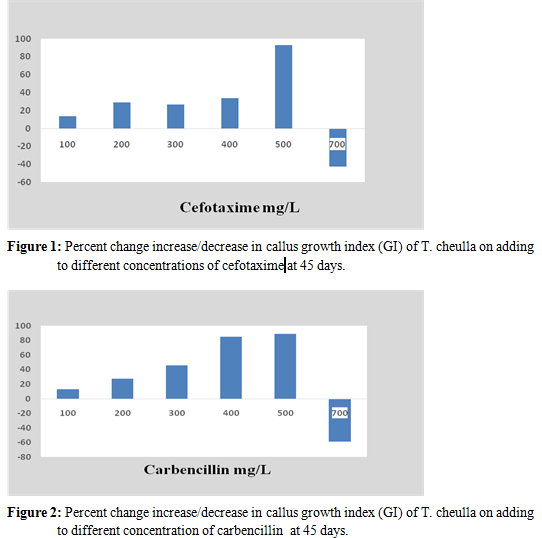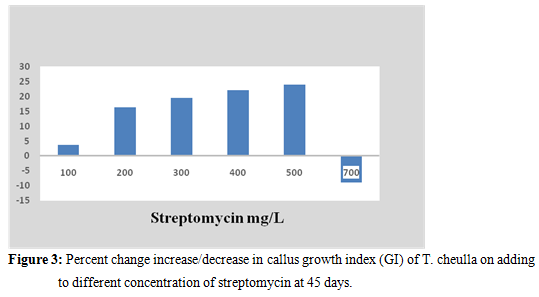Welcome to IJCRR
Indexed and Abstracted in: Crossref, CAS Abstracts, Publons, Google Scholar, Open J-Gate, ROAD, Indian Citation Index (ICI), ResearchGATE, Ulrich's Periodicals Directory, WorldCat (World's largest network of library content and services)
|
Growth index (GI) = |
Final callus fresh weight - Initial callus fresh weight |
X 100 |
|
Initial callus fresh weight |
Antibiotic treatments of callus cultures carbenicillin, cefotaxime and streptomycin were dissolved in double distilled water (DDW), filtered-sterilized and added to the liquid medium after autoclaving all the above antibiotics were added to the callus culture medium at different concentrations i.e., 100 mg/l, 200 mg/l, 300mg/l, 400mg/l, 500mg/l 700mg/l. Control were maintained without antibiotics, the effects of antibiotics and the growth of callus on solid medium after 45 days. Duncan's Multiple Range Test(1955) was used to determine the statistically significance among control and antibiotic treated callus. All quantification measurements were expressed as mean ± SEM for each experiment 8 replications were cited.
Results
From the date presented in the Table 1 and Figure 1, it is observed that relative to growth index of callus in Terminalia chebula. After 45 days significantly increased on cefotaxime treatment. The increase in the callus growth index was highest at the concentration of 500 mg/l. However, at the concentration of 700 mg/L the growth index was less when compare to controls. The order of increase was 100<200<300<400<500. Carbenicillin treated callus cultures also (Table 2 and Figure 2) showed significant increase in callus growth index and highest at 500 mg/l and negative impact exhibited at 700 mg/l of carbenicillin. The order of increase in callus growth index was 100  200
200  300
300  400
400  500. Streptomycin added callus culture also showed (Table 3 and Figure 3) an increase growth index but degree of increase was less when compared to cefotaxime and carbenicillin. The increase in growth index was concentration dependent up to 500 mg/l and growth index decreased at 700 mg/l of streptomycin. The order of growth increase was 100<200<300<400<500.
500. Streptomycin added callus culture also showed (Table 3 and Figure 3) an increase growth index but degree of increase was less when compared to cefotaxime and carbenicillin. The increase in growth index was concentration dependent up to 500 mg/l and growth index decreased at 700 mg/l of streptomycin. The order of growth increase was 100<200<300<400<500.
Discussion
In the present investigation scope of high production of callus from the T. chebula was examined. It is known that callus induction and growth is dependent on different growth hormones and explants and relationship existed between growth hormones and biomass production. Kim et. al., 2001, supplemented culture media with 0.5mg/L of 2, 4-dichlro phenoxy acetic acid (2-4-D) and observed highest callus yield in Agastache rugosa O Kuntaze. However, realizing the importance of antibiotics in plant tissue culture we attempted to apply antibiotics ability to enhance T. chebula callus culture yield at higher level. In our study, β-lactam antibiotics such as cefotaxime and carbenicillin exhibited positive effects on callus growth. Further, more aminoglycoside antibiotics such as streptomycin also exhibited positive effect on callus growth but not significant effect when compared to controls. Danilova and Dolgikhi, (2004) exhibited a stimulatory effect in maize callus cultures. The activity of cefotaxime was attributed to the fact that plant esterases might have degraded into new metabolites and these metabolites might have showed growth regulation activity (Mathias and Boyed,1986). Quin et al., (2011) also reported that carbenicillin exhibited both stimulation and inhibitory effect. According to Holford and Newbury, (1992), carbenicillin molecular structure possess a structure similar to auxin and in media the carbenicillin is broken down to physiologically active phenyl acetic acid which can induce auxin like effect. It was noticed that very little callus growth was observed the concentration of 300 mg/l-1 of carbenicillin in carrot (Chang and Schmidt, 1991). Streptomycin is one of the antibiotic belonging to the category of aminoglucoside antibiotic which inhibits the growth of plant cells by binding to the 30S ribosome subunit (Biswas and Gorini, 1972). In contrary with earlier report our results exhibited positive effect at all concentrations of streptomycin, however, the effect was insignificant. This could be due to the stress of streptomycin on the callus cells as reported in the earlier studies.
On the whole it is concluded that addition of antibiotics such as cefotaxime, carbenicillin and streptomycin were not toxic to callus formation. Further these antibiotics enabled to enhance the callus culture when compared to controls in the range of 100-500 mg/L. Hence these antibiotics can be used for enhancement of callus production. However, further studies are needed to elucidate the biochemical mechanism of antibiotics in relation to enhancement of callus growth and development.
Conclusion
Broad spectrum antibiotics are being used in plant tissue cultures to reduce in vitro contamination. Our studies revealed that antibiotics such as cefotaxime and carbencillin significantly increased the callus production at critical concentrations. It is concluded that carbencillin and cefotaxime acts as growth promoting substances and this could be attributed to the chemical structured similarities of antibiotics with some growth hormones.
Acknowledgements
We highly acknowledge the Head, Department of Sericulture, S.K. University, Anathapuramu, and the Director of BIOTRIM (Dept. of Forest, Tirupati, and A.P.) for providing laboratory facilities.
Table 1: Effect of Cefotaxime on the growth index (GI) of callus of T. Chebulla after 45 days of incubation in solid media.
|
Cefotaxime (mg/L) |
Callus initial Fresh weight (mg) |
Callus final Fresh weight (mg) |
Growth index (GI) |
|
0 |
50±10 |
925 |
1750 b ±0.07 |
|
100 |
50±10 |
1045 |
1990 b ±0.06 (+ 13.71) |
|
200 |
50±10 |
1150 |
2200 c ±0.05 (+ 29.02) |
|
300 |
50±10 |
1179 |
2258 c (+ 26.50) |
|
400 |
50±10 |
1220 |
2340 c ±0.3 (+33.71) |
|
500 |
50±10 |
1740 |
3380 d ±1.1 (+93.14) |
|
700 |
50±10 |
470 |
910 a ±1.0 (-48.0) |
* Each value is a mean of eight estimations.
** Per cent decrease over control is given in parenthesis.
*** Mean within a column followed by the same letter are not significantly different (p>0.05) from each other according to Duncan‘s Multiple range test.
Mean ± SEM
Table 2: Effect of carbenicillin on the growth index of callus(GI) of T. Chebulla after 45 days of incubation in solid media.
|
Carbenicillin (mg/L) |
Callus initial Fresh weight(mg) |
Callus final Fresh weight (mg) |
Growth index (GI) |
|
0 |
50±10 |
0874 |
1648b ±0.5 |
|
100 |
50±10 |
0978 |
1856 b ±1.2 ( 12.62) |
|
200 |
50±10 |
1100 |
2100 c ±4.4 (27.42) |
|
300 |
50±10 |
1252 |
2404 d ±1.7 ( 45.87) |
|
400 |
50±10 |
1565 |
3030 e ±2.9 (85.07) |
|
500 |
50±10 |
1607 |
3114 e ±0.6 (88.95) |
|
700 |
50±10 |
0534 |
680 a ±5.0 (-58.73) |
* Each value is a mean of eight estimations.
** Per cent decrease over control is given in parenthesis.


References:
Indexed and Abstracted in






Antiplagiarism Policy: IJCRR strongly condemn and discourage practice of plagiarism. All received manuscripts have to pass through "Plagiarism Detection Software" test before forwarding for peer review. We consider "Plagiarism is a crime"
IJCRR Code of Conduct: To achieve a high standard of publication, we adopt Good Publishing Practices (updated in 2022) which are inspired by guidelines provided by Committee on Publication Ethics (COPE), Open Access Scholarly Publishers Association (OASPA) and International Committee of Medical Journal Editors (ICMJE)
Disclaimer: International Journal of Current Research and Review (IJCRR) provides platform for researchers to publish and discuss their original research and review work. IJCRR can not be held responsible for views, opinions and written statements of researchers published in this journal.
International Journal of Current Research and Review (IJCRR) provides platform for researchers to publish and discuss their original research and review work. IJCRR can not be held responsible for views, opinions and written statements of researchers published in this journal
148, IMSR Building, Ayurvedic Layout,
Near NIT Complex, Sakkardara,
Nagpur-24, Maharashtra State, India
editor@ijcrr.com
editor.ijcrr@gmail.com
 This work is licensed under a Creative Commons Attribution-NonCommercial 4.0 International License
This work is licensed under a Creative Commons Attribution-NonCommercial 4.0 International License
Copyright © 2025 IJCRR. Specialized online journals by ubijournal